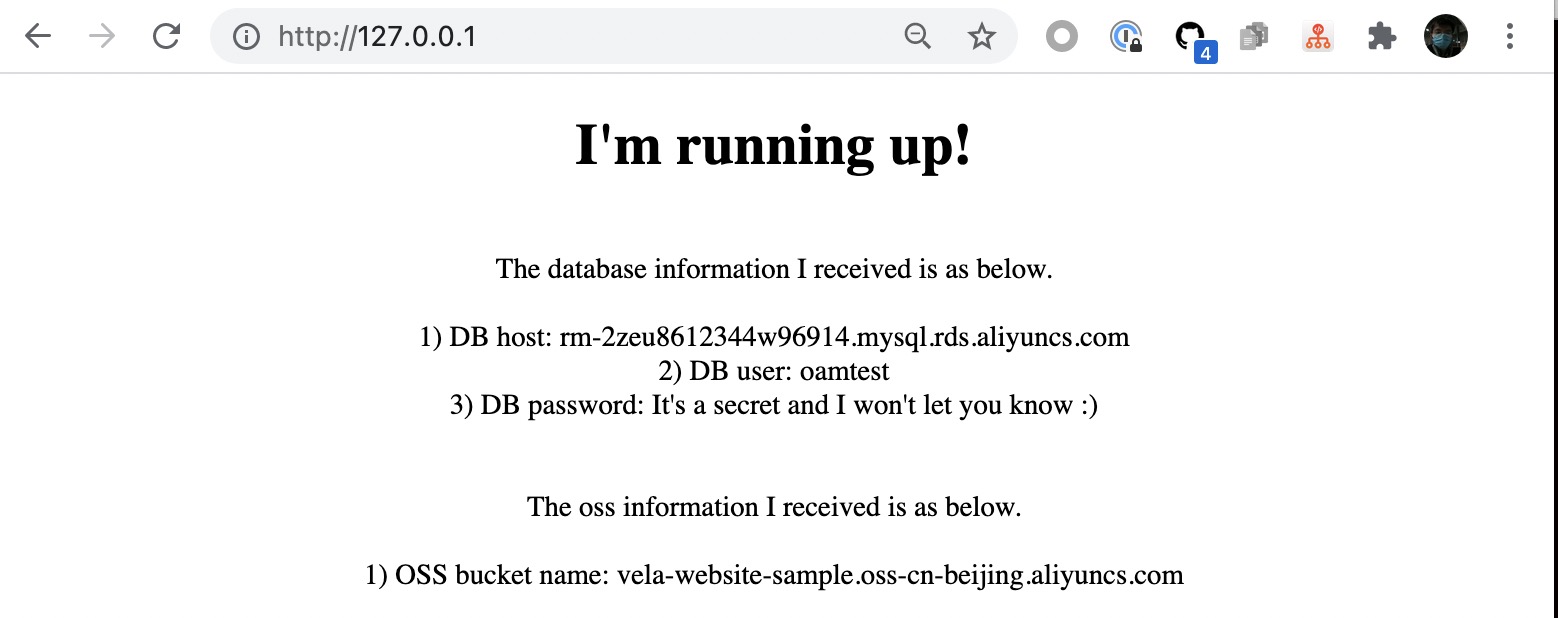Provision and Binding Cloud Resources
Cloud-oriented development is now becoming the norm, there is an urgent need to integrate cloud resources from different sources and types. Whether it is the most basic object storage, cloud database, or load balancing, it is all faced with the challenges of hybrid cloud, multi-cloud and other complex environments. KubeVela is perfect to satisfy the needs.
KubeVela efficiently and securely integrates different types of cloud resources through resource binding capabilities in cloud resource Components and Traits. At present, you can directly use the default components of those cloud resources below. At the same time, more new cloud resources will gradually become the default option under the support of the community in the future. You can use cloud resources of various manufacturers in a standardized and unified way.
This tutorial will talk about how to provision and consume Cloud Resources by Terraform.
⚠️ This section requires your platform engineers have already enabled cloud resources addon.
Terraform
All supported Terraform cloud resources can be seen in the list. You can also filter them by command by vela components --label type=terraform.
Provision cloud resources
Use the following Application to provision an OSS bucket:
apiVersion: core.oam.dev/v1beta1
kind: Application
metadata:
name: provision-cloud-resource-sample
spec:
components:
- name: sample-oss
type: alibaba-oss
properties:
bucket: vela-website-0911
acl: private
writeConnectionSecretToRef:
name: oss-conn
The above alibaba-oss component will create an OSS bucket named vela-website-0911, with private acl, with connection information stored in a secreted named oss-conn.
description, whether it's compulsory, and default value.
Apply the above application, then check the status:
$ vela ls
APP COMPONENT TYPE TRAITS PHASE HEALTHY STATUS CREATED-TIME
provision-cloud-resource-sample sample-oss alibaba-oss running healthy Cloud resources are deployed and ready to use 2021-09-11 12:55:57 +0800 CST
After the phase becomes running and healthy, you can then check the OSS bucket in Alibaba Cloud console or by ossutil
command.
$ ossutil ls oss://
CreationTime Region StorageClass BucketName
2021-09-11 12:56:17 +0800 CST oss-cn-beijing Standard oss://vela-website-0911
Bind cloud resources
Let's deploy the application below to provision Alibaba Cloud OSS and RDS cloud resources, and consume them by the web component.
apiVersion: core.oam.dev/v1beta1
kind: Application
metadata:
name: webapp
spec:
components:
- name: express-server
type: webservice
properties:
image: zzxwill/flask-web-application:v0.3.1-crossplane
port: 80
traits:
- type: service-binding
properties:
envMappings:
# environments refer to db-conn secret
DB_PASSWORD:
secret: db-conn # 1) If the env name is the same as the secret key, secret key can be omitted.
endpoint:
secret: db-conn
key: DB_PUBLIC_HOS # 2) If the env name is different from secret key, secret key has to be set.
username:
secret: db-conn
key: DB_USER
# environments refer to oss-conn secret
BUCKET_NAME:
secret: oss-conn
- name: sample-db
type: alibaba-rds
properties:
instance_name: sample-db
account_name: oamtest
password: U34rfwefwefffaked
writeConnectionSecretToRef:
name: db-conn
- name: sample-oss
type: alibaba-oss
properties:
bucket: vela-website-0911
acl: private
writeConnectionSecretToRef:
name: oss-conn
The component sample-db will generate secret db-conn with these keys, and the component
sample-oss will generate secret oss-conn. These secrets are binded to the Envs of component express-server by trait
Service Binding. Then the component can consume instances of OSS and RDS.
Deploy and verify the application.
$ vela ls
APP COMPONENT TYPE TRAITS PHASE HEALTHY STATUS CREATED-TIME
webapp express-server webservice service-binding running healthy 2021-09-08 16:50:41 +0800 CST
├─ sample-db alibaba-rds running healthy 2021-09-08 16:50:41 +0800 CST
└─ sample-oss alibaba-oss running healthy 2021-09-08 16:50:41 +0800 CST
$ vela port-forward webapp
Forwarding from 127.0.0.1:8080 -> 80
Forwarding from [::1]:8080 -> 80
Forward successfully! Opening browser ...
